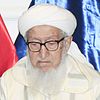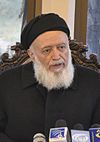President of Afghanistan
| President of the Islamic Republic of Afghanistan | |
|---|---|
| د افغانستان ولسمشر (Pashto) رئیس جمهور افغانستان (Dari) | |
 | |
 | |
| Status | Office abolished |
| Member of | Cabinet |
| Residence | The Arg |
| Seat | Kabul |
| Appointer | Direct election |
| Term length | 5 years, renewable once |
| Precursor | King of Afghanistan |
| Formation |
|
| First holder | Mohammed Daoud Khan |
| Final holder | Ashraf Ghani |
| Abolished | 15 August 2021 |
| Superseded by | Supreme Leader |
| Deputy | Vice President |
| Salary | ؋960,000 monthly[1] |
| Website | president.gov.af (inactive) (15 August 2021 archive) |
The president of the Republic of Afghanistan was constitutionally the head of state and head of government of the Republic of Afghanistan (1987–1992) and Commander-in-Chief of the Afghan Armed Forces.
After the Fall of Kabul in 1992, he was deposed and replaced by the Islamic State.
Eligibility and selection process
[edit]Article 62 of the 2004 Constitution of Afghanistan stated that a candidate for the office of President had to:[2]
- be a citizen of Afghanistan, Muslim, born of Afghan parents;
- not be a citizen of another country;
- be at least forty years old when declaring candidacy;
- not have been convicted of crimes against humanity, a criminal act or deprived of civil rights by a court;
- not have previously served more than two terms as president.
Powers
[edit]The 2004 Constitution granted the president wide powers over military and legislative affairs, with a relatively weak national bicameral National Assembly, the House of the People (Wolesi Jirga) and the House of Elders (Meshrano Jirga). A president could only serve up to two five-year terms.
Hamid Karzai began his first five-year term in 2004.[3] After his second term ended in 2014, Ashraf Ghani was elected as the next Afghan president.[4]
 |
|---|
|
|
This is a list of Presidents of Afghanistan. Afghanistan has only intermittently been a republic – between 1973–1992 and from 2001 onward – at other times being governed by a variety of kings, emirs, as well as mujahideen and Taliban leaders in the 1990s.
The present constitution of Afghanistan grants the president wide powers over military and legislative affairs, with a relatively weak national parliament. These were a subject of considerable controversy when debated by the country's Loya jirga ("Grand assembly") in December 2003. However, they were seen by the Transitional Administration and its Western backers as being essential to securing the stability of Afghanistan.
The former president Hamid Karzai became the first ever democratically elected head of state in Afghanistan on December 7, 2004. The current president is Mohammad Ashraf Ghani, since September 29, 2014.
List
[edit]| Name | Portrait | Lifespan | Term of office | Political party | |||
|---|---|---|---|---|---|---|---|
| Took office | Left office | Time in office | |||||
| Republic of Afghanistan (1973–1978) | |||||||
| Mohammed Daoud Khan | 
|
1909–1978 | 17 July 1973 | 28 April 1978 | 4 years, 285 days | Independent (until 1976) | |
| National Revolutionary Party | |||||||
| President; Member of the Barakzai dynasty (first cousin of Mohammed Zahir Shah); Assassinated with most of his family during the Saur Revolution.[5] Shortly afterwards, the new military leaders announced that Khan was killed for refusing to surrender.[6] | |||||||
| Democratic Republic of Afghanistan (1978–1992) | |||||||
| Colonel Abdul Qadir |

|
1944–2014 | 28 April 1978 | 30 April 1978 | 2 days | People's Democratic Party (Khalq faction) | |
| Chairman of the Presidium of the Military Revolutionary Council | |||||||
| Nur Muhammad Taraki | 
|
1917–1979 | 30 April 1978 | 14 September 1979 | 1 year, 137 days | People's Democratic Party (Khalq faction) | |
| Chairman of the Presidium of the Revolutionary Council; Assassinated by orders of Hafizullah Amin | |||||||
| Hafizullah Amin | 1929–1979 | 14 September 1979 | 27 December 1979 | 104 days | People's Democratic Party (Khalq faction) | ||
| Chairman of the Presidium of the Revolutionary Council; Assassinated by Soviet special forces during the Operation Storm-333[7] | |||||||
| Babrak Karmal | 
|
1929–1996 | 27 December 1979 | 24 November 1986 | 6 years, 332 days | People's Democratic Party (Parcham faction) | |
| Chairman of the Presidium of the Revolutionary Council; Dismissed | |||||||
| Haji Mohammad Chamkani | 
|
1947–2012 | 24 November 1986 | 30 September 1987 | 310 days | Independent | |
| Chairman of the Presidium of the Revolutionary Council; Appointed as part of the National Reconciliation process | |||||||
| Mohammad Najibullah | 
|
1947–1996 | 30 September 1987 | 16 April 1992 | 4 years, 199 days | People's Democratic Party (Parcham faction) (until 1990) | |
| Homeland Party | |||||||
| President (Chairman of the Presidium of the Revolutionary Council until 30 November 1987); Resigned | |||||||
| Abdul Rahim Hatif | 
|
1926–2013 | 16 April 1992 | 28 April 1992 | 12 days | Homeland Party | |
| Acting President; Deposed | |||||||
| Islamic State of Afghanistan (1992–2002) | |||||||
| Sibghatullah Mojaddedi | 
|
1926–2019 | 28 April 1992 | 28 June 1992 | 61 days | National Liberation Front of Afghanistan | |
| Acting President; Resigned | |||||||
| Burhanuddin Rabbani | 
|
1940–2011 | 28 June 1992 | 22 December 2001 | 9 years, 167 days | Jamiat-e Islami | |
| President; Between 1996 and 2001, the Islamic State remained the internationally recognized government, despite only controlling about 10% of Afghan territory | |||||||
| Hamid Karzai | 
|
born 1957 | 22 December 2001 | 13 July 2002 | 203 days | Independent | |
| Acting President | |||||||
| Islamic Emirate of Afghanistan (1996–2001) | |||||||
| Mullah Mohammed Omar |
1960–2013 | 27 September 1996 | 13 November 2001 | 5 years, 47 days | Taliban | ||
| Emir and Commander of the Faithful; The Islamic Emirate never attained widespread international recognition, despite controlling about 90% of Afghan territory; Deposed | |||||||
| Transitional Islamic State of Afghanistan (2002–2004) | |||||||
| Hamid Karzai | 
|
born 1957 | 13 July 2002 | 7 December 2004 | 2 years, 147 days | Independent | |
| Transitional President; Appointed at the 2002 loya jirga | |||||||
| Islamic Republic of Afghanistan (2004–2021) | |||||||
| Hamid Karzai | 
|
born 1957 | 7 December 2004 | 29 September 2014 | 9 years, 296 days | Independent | |
| President; First democratically elected head of state; Elected in 2004 and re-elected in 2009 | |||||||
| Ashraf Ghani | 
|
born 1949 | 29 September 2014 | 15 August 2021 | 6 years, 320 days | Independent | |
| President; First peaceful transition of power; Elected in 2014 and re-elected in 2019; He escaped from Afghanistan, during the Fall of Kabul[8] | |||||||
| Amrullah Saleh | 
|
born 1972 | 17 August 2021 | 6 September 2021 | 20 days | Independent | |
| First Vice President; Claimed the position of caretaker president based on Article 67 of the 2004 Constitution[9] | |||||||
| Islamic Emirate of Afghanistan (2021–present) | |||||||
See also
[edit]References
[edit]- ^ "Afghanistan's lower house approves President Karzai's salary and expenses amount". Wadsam. 1 June 2013. Retrieved 15 August 2021.
- ^ "The Constitution of the Islamic Republic of Afghanistan". Government of Afghanistan. Retrieved 5 February 2013.
- ^ Gall, Carlotta (4 November 2004). "Election of Karzai Is Declared Official". The New York Times. Retrieved 15 August 2021.
- ^ "Ashraf Ghani sworn in as new Afghan president". BBC News. 29 September 2014. Retrieved 25 July 2021.
- ^ "There was, therefore, little to hinder the assault mounted by the rebel 4th Armored Brigade, led by Major Mohammad Aslam Watanjar, who had also been prominent in Daoud's own coup five years before. Watanjar first secured the airport, where the other coup leader, Colonel Abdul Qadir, left by helicopter for the Bagram air base. There he took charge and organized air strikes on the presidential palace, where Daoud and the presidential guard were conducting a desperate defense. Fighting continued the whole day and into the night, when the defenders were finally overwhelmed. Daoud and almost all of his family members, including women and children, died in the fighting. Altogether there were possibly as many as two thousand fatalities, both military and civilian." p. 88 of Ewans, Martin (2002) Afghanistan: A Short History of Its People and Politics HarperCollins, New York, Page 88 ISBN 0-06-050507-9
- ^ "1978: Afghan coup rebels claim victory". 29 April 1978 – via news.bbc.co.uk.
- ^ "How Soviet troops stormed Kabul palace". BBC. 27 December 2009. Retrieved 3 August 2021.
- ^ https://www.nytimes.com/2021/08/16/world/asia/afghanistan-president-ashraf-ghani.html. Retrieved 31 August 2021
- ^ Landay, Jonathan; Macfie, Nick; Boyle, John (17 August 2021). "Afghan vice president says he is "caretaker" president". Reuters. Retrieved 17 August 2021.
